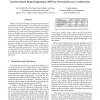Free Online Productivity Tools
i2Speak
i2Symbol
i2OCR
iTex2Img
iWeb2Print
iWeb2Shot
i2Type
iPdf2Split
iPdf2Merge
i2Bopomofo
i2Arabic
i2Style
i2Image
i2PDF
iLatex2Rtf
Sci2ools
104
Voted
DATE
2005
IEEE
2005
IEEE
Assertion-Based Design Exploration of DVS in Network Processor Architectures
With the scaling of technology and higher requirements on performance and functionality, power dissipation is becoming one of the major design considerations in the development of network processors. In this paper, we use an assertion-based methodology for system-level power/performance analysis to study two dynamic voltage scaling (DVS) techniques, trafficbased DVS and execution-based DVS, in a network processor model. Using the automatically generated distribution analyzers, we analyze the power and performance distributions and study their trade-offs for the two DVS policies with different parameter settings such as threshold values and window sizes. We discuss the optimal configurations of the two DVS policies under different design requirements. By a set of experiments, we show that the assertion-based trace analysis methodology is an efficient tool that can help a designer easily compare and study optimal architectural configurations in a large design space.
Related Content
| Added | 24 Jun 2010 |
| Updated | 24 Jun 2010 |
| Type | Conference |
| Year | 2005 |
| Where | DATE |
| Authors | Jia Yu, Wei Wu, Xi Chen, Harry Hsieh, Jun Yang 0002, Felice Balarin |
Comments (0)

